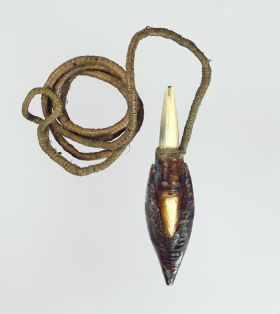Harpoon point hooks ‘quaboolshtl
Place: Nootka
Category: Fishing & hunting
mussel shell, bone, animal sinew, bark, Nootka Sound, northern Pacific, l. 13 cm (harpoon), 99 cm (cord), Inv. Am 663
Cook: Hooks’quaboolshtl
Humphrey No. 289: ‘The Head of a Harpoon, made of a large Muscle shell, ground very sharp at the points & edges, and cemented with a resinous gum to two barbs made of the bones of some marine animal strongly tied together and to the Line, which is wolded with a sort of With; between the two bones is a hollow for the Staff, which upon the fish being struck quits the head and the Line being fixed at the side of it so draws that it is impossible for the Creature to extracate itself from it: The Line being fastened to the Staff the latter floats & is followed by the Natives in their canoes, till the fish is spent. Large fish are unusually struck therewith as Whales, Grampus, Sharks etc. From King George’s Sound on the North-West Coast of America Lat. 49. 50.’
A lance-shaped tip made of a concave piece of a mussel shell, white on the inside and violet outside, is cemented between two pieces of bone pointed at both ends, the lower ends of which form a support for the front end of a harpoon shaft. Affixed to the underneath of the shell tip is a thick, two-ply, Z-twisted cord made of animal sinews, ending in a loop, and mostly wrapped with brown bark strips. Humphrey’s description in the catalogue of the collection is especially detailed, his comments supported by the other sources pertaining to the third voyage (Beaglehole 1967, Illa: 320n1, 324; Illb: 1103, 1324, 1410; Ledyard 1963: 76-77; Zimmerman 1981: 82).
In addition to the Göttingen harpoon point, which has already been described and illustrated by Haberland (1979: 211, J-14), there are nine other examples which can be documented as being from the third voyage. Two examples each can be found in Vienna (Feest 1995), Berne (Henking 1957: 369f., Fig. 36-37; Thompson 1977: 112, Fig. 8; Kaeppler 1978b: 64f., Fig. 123-24) and Herrnhut, respectively (Augustin 1993: 83f., Fig. 19). One of the three comparable pieces from the British Museum has been lost (King 1981: 90f., PI. 83). In the Leverian Museum, Sarah Stone drew a very similar harpoon point, as well as three more with different bone points (Force and Force 1968: 159f.). Christian F. Feest
Sources
Augustin, Stephan, Kunstsachen von Cooks Reisen - Die Sammlung und ihre Geschichte im Völkerkundemuseum Herrnhut, Museum für Völkerkunde, Dresden,1993.
Beaglehole, John Cawte, The Journals of Captain James Cook on his Voyages of Discovery The Voyage of the Resolution and Discovery 1776-1780, Hakluyt Society, Extra Series, 36, 1 u. 2. vol. 3, Cambridge University Press, Cambridge, 1955-1967 IIIa and IIIb.
Feest, Christian F, ‘Cook voyage material from North America: The Vienna Collection’, Archiv für Völkerkunde, Vienna, 1995, vol. 49, pp. 111-186.
Force, Roland and Force, Maryanne, Art and Artifacts of the Eighteenth Century, Honolulu, 1968.
Haberland, Wolfgang, Donnervogel und Raubwal. Indianische Kunst der Nordwestküste Nordamerikas, Hamburg, 1979.
Henking, Karl H, ‘Die Südsee- und Alaskasammlung Johann Wäber. Beschreibender Katalog’, in Jahrbuch der Bernischen Historischen Museums in Bern, 1957, vols 35-36, pp. 325-389.
Kaeppler, Adrienne L, Cook Voyage Artifacts in Leningrad, Berne and Florence Museums, Bishop Museum Press, Honolulu, 1978b.
King, JCH, Artificial Curiosities from the Northwest Coast of North America, London, 1981.
Ledyard, John, John Ledyard’s Journal of Captain Cook’s Last Voyage [1783], JK Munford (trans.), Corvallis, 1963.
Thompson, Judy, The North American Indian Collection: A Catalogue, Bern, 1977.
Zimmermann, Heinrich, Reise um die Welt mit Cap. Cook [1781], Insel Taschenbuch 555, Frankfurt a. M. 1981.

